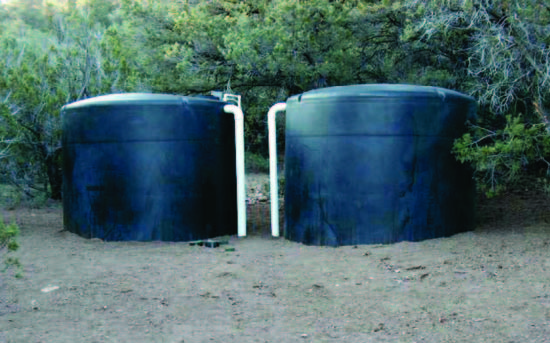The PermaDesign Weblog, with Nate Downey and Melissa McDonald!
Roof-Reliant Landscaping™ Step 17C: Water Storage - Partially Buried Cisterns

Two partially buried cisterns
A partially buried cistern is a water-storage tank situated such that the bottom portion of the cistern and its pressurized pipe are protected by the soil from freezing. The remainder of the tank is exposed to the elements (particularly sunlight).
Advantages. In certain situations, partially buried cisterns offer an excellent alternative for people on a limited budget. Compared to an underground cistern system, installation cost savings for partially buried cisterns are significant and the aesthetic issues associated with aboveground cistern systems are easier to solve. Partially burying a cistern also solves the potential problems of water freeze damage, and partially buried cisterns also have the potential for
eliminating the need for a water pump.
If your storage tank is small enough, it may be possible to excavate the hole for a partially buried cistern with picks and shovels as opposed to using a backhoe. If you dig the hole by hand, the cost savings could be considerable, but be aware that this is very strenuous work. Renting a backhoe can be cost-effective, but manual excavation makes the most sense in situations where backhoe access is difficult. In the case of new construction, consider excavating your hole when a backhoe is already on site—another cost-benefit of landscape planning.
Manufacturers are not inclined to endorse partially burying a cistern that is intended for underground use. That is because underground tanks are typically not UV protected, which means they will not last long in the bright New Mexico sun. Also, the walls of underground tanks use the earth around them to support the massive weight of water in a full cistern, so the walls of underground tanks are often much thinner than their aboveground counterparts and often cannot be used without the support of properly compacted earth around them.
Typically, the most important reason to partially bury a cistern is to keep your pipes from freezing. Before renting a backhoe, determine your local frost depth. (Contact your local County Cooperative Extension Office, http://cahe.nmsu.edu/county/ ). Then, if you plan to partially bury an aboveground cistern, make sure your tank can withstand the inward pressure on the tank’s walls at the selected depth when your cistern tank is empty.
Disadvantages. The main disadvantage of a partially buried cistern is that after all of your hard work digging, the tank looks like a smaller version of an aboveground cistern. Yes, money has been saved and the pipes are less likely to freeze, but many people will still want to invest in a fence or dense plants to hide the exposed portion of the tank.
In many situations, a partially buried cistern is a perfect mix of cost savings and frost prevention. However, just as partially buried systems come with many of the advantages of aboveground and underground cisterns, they also come with many of the same disadvantages. Therefore, if you are already thinking of excavating with a backhoe for a partially buried cistern, you may wish to choose an underground cistern instead.
02/16/2016 | (0) Comments










Comments